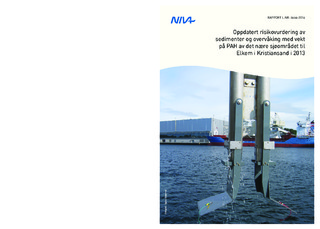Oppdatert risikovurdering av sedimenter og overvåking med vektpå PAH av det nære sjøområdet til Elkem i Kristiansand i 2013
Næs, Kristoffer; Håvardstun, Jarle; Oug, Eivind; Beyer, Jonny; Bakke, Torgeir Heggelund; Heiaas, Harald; Lillicrap, Adam David; Allan, Ian
Research report
Permanent lenke
http://hdl.handle.net/11250/195466Utgivelsesdato
2014Metadata
Vis full innførselSamlinger
- NIVA-rapporter [6995]
- Publikasjoner fra Cristin - NIVA [2149]
Originalversjon
Næs, K.; Håvardstun, J.; Oug, E. et al. 2014 Oppdatert risikovurdering av sedimenter og overvåking med vekt på PAH av det nære sjøområdet til Elkem i Kristiansand i 2013 (NIVA-rapport; 6664) 107 p.Sammendrag
Bedriftene Elkem Carbon AS og Elkem Solar AS gjennomfører et overvåkingsprogram i det bedriftsnære sjøområdet i Kristiansandsfjorden. Programmet supplerer og er koplet opp mot myndighetenes generelle overvåking av Kristiansandsfjorden. Undersøkelsene i 2013 har vært todelt: en risikovurdering av sedimentene i Elkembukta og Fiskåbukta og en videreføring av den langsiktige overvåkingen av det nære sjøområdet til Elkem med hovedvekt på PAH. Det ble ikke observert systematiske endringer i metall- eller PAH-innhold i vannmassene over den 3- årsperioden overvåkingen har foregått. Metallinnholdet i blåskjell var generelt lavt til svakt forhøyet. PAH-innholdet i skjellene var til dels høyt i de helt bedriftsnære områdene. Konsentrasjonen av forurensede forbindelser i sedimentet i Elkembukta danner utgangspunktet for risikovurderingene. Verdiene var høye. En transport av PAH fra sedimentene er underordnet andre kilder til Elkembukta hvor PAH med prosessvann nå er sterkt redusert i forhold til tidligere. De forurensede sedimentene i Elkembukta representerer en beregnet risiko for økologiske effekter og gir også en human risiko hvis sjømat hentes fra denne industrihavnen. Det er neppe tilfelle i særlig grad og PAH akkumuleres heller ikke i filet av fisk slik at eventuell risiko i hovedsak vil være knyttet til skjell. Den økologiske tilstanden til bløtbunnsfaunaen i området Fiskåbukta utenfor Elkembukta er generelt god og har vist en betydelig forbedring over tid.
Elkem Carbon AS and Elkem Solar AS are conducting a monitoring program in the Kristiansand fjord near their factories. This program supplements the authorities overall monitoring and surveillance programme in the Kristiansand fjord. In 2013, samples of the water masses, blue mussels, sediments and ecological status of the soft bottom fauna were investigated and a risk assessment study of the contaminated sediments was performed. No systematic changes in metal or PAH concentrations in the water masses over the three-year monitoring period could be detected. Metal content in mussels was generally low to slightly elevated, however PAH content in mussels was elevated. Contaminant concentrations were high in the Elkem harbour sediments. The sediment contaminant concentrations were used in a risk assessment. Calculations gave a transport of approx. 3 kg PAH annually from the sediments. The directed discharges of PAH with process water is now strongly reduced to approx. 10 kg/yr. The contaminated sediments represent a calculated risk for sediment-living organisms and to humans based on a lifelong intake of seafood from the area. The latter is not necessarily realistic since fishing in the area hardly occurs and PAH do not accumulate in fish flesh. The quality of the benthic fauna in the Fiskåbukta has improved significantly over the years and might have reached a status as good as can be expected in a mulitisource, urbanized area. Elkem Carbon AS and Elkem Solar AS are conducting a monitoring program in the Kristiansand fjord near their factories. This program supplements the authorities overall monitoring and surveillance programme in the Kristiansand fjord. In 2013, samples of the water masses, blue mussels, sediments and ecological status of the soft bottom fauna were investigated and a risk assessment study of the contaminated sediments was performed. No systematic changes in metal or PAH concentrations in the water masses over the three-year monitoring period could be detected. Metal content in mussels was generally low to slightly elevated, however PAH content in mussels was elevated. Contaminant concentrations were high in the Elkem harbour sediments. The sediment contaminant concentrations were used in a risk assessment. Calculations gave a transport of approx. 3 kg PAH annually from the sediments. The directed discharges of PAH with process water is now strongly reduced to approx. 10 kg/yr. The contaminated sediments represent a calculated risk for sediment-living organisms and to humans based on a lifelong intake of seafood from the area. The latter is not necessarily realistic since fishing in the area hardly occurs and PAH do not accumulate in fish flesh. The quality of the benthic fauna in the Fiskåbukta has improved significantly over the years and might have reached a status as good as can be expected in a mulitisource, urbanized area.

